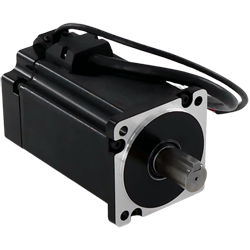Anaheim Automation offers a wide variety of standard brushless DC motors. However, OEM customers with medium to large quantity requirements may prefer to have a
motor customized or modified to meet their exact design specifications. Oftentimes the customization is as simple as shaft modification, the addition of a brake, an oil
seal for an IP65 rating, adjusted mounting dimensions, different wire colors, or a custom label. At other times, a customer may require that a motor be designed to meet
ideal specifications such as speed, torque, and/or voltage.
Anaheim Automation's BLDC motor customer base is diverse, including: companies running or designing automated machinery or functions that involve food, cosmetics or
medical packaging, labeling or tamper-evident requirements, assembly, conveyor, material handling, robotics, special filming and projection effects, medical diagnostics,
inspection and security devices, pump flow control, metal fabrication (CNC machinery), equipment upgrades, and more. Many OEM customers request private-labeling of their
custom designs to ensure that they maintain the loyalty of their own customers for servicing, replacements and repairs.
Buyers appreciate the convenience Anaheim Automation's capacity as a one-stop-shop, as well as the cost savings of a custom brushless motor custom design. Engineers value
the creativity, system efficiency, and flexibility that Anaheim Automation presents for their BLDC product line. Our standard brushless motors are known for their rugged
construction, excellent performance, and cost-effectiveness.
A considerable portion of our sales results from our ability to surpass customer expectations in fulfilling their custom requirements. While a good portion of Anaheim
Automations Brushless DC Motors sales consist of custom, special, or private-labeling requirements, we take pride in our stock of standard units, located in Anaheim,
California, USA. To make the customization process affordable, a minimum order quantity (MOQ) and/or a Non-Recurring Engineering (NRE) fee may be required. All sales of
customized or modified brushless DC motors are Non-Cancelable-Non-Returnable, and a NCNR Agreement must be signed by the customer at the time the order is placed. The NCNR
may be required to be renewed with each purchase request.
All sales, including custom designs, are pursuant to Anaheim Automation's standardized Terms and Conditions, which take precedence over any other expressed or implied
terms, including but not limited to any implied warranties.
PLEASE NOTE: Technical support regarding its Brushless DC Motors, or any and all other products manufactured or distributed by Anaheim Automation,
will be offered at no charge. This assistance is provided to assist the customer in choosing Anaheim Automation products for a specific application. However, any
application, selection, or quotation recommendation for any product provided by Anaheim Automation staff, distributors, or representatives is provided solely to assist the
customer. In all cases, the customer is solely responsible for the determination of fitness of the standard or custom product for a given system design. While every effort
is made to offer solid advice regarding our products, and to provide accurate technical data and illustrations, please note that such advice and documents are for
reference only, and are subject to change without notice.



.png)
.png)
.png)
.png)
.png)
.png)
.png)
.png)
.png)
.png)